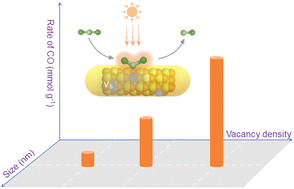Anion vacancy correlated photocatalytic CO2 to CO conversion over quantum-confined CdS nanorods under visible light†
Abstract
Surface vacancies in II–VI semiconductors have been confirmed as active sites for photocatalytic CO2 reduction. Here we take quantum-confined CdS nanorod as a model photocatalyst to correlate anion vacancies with photocatalytic CO2 reduction performance. In terms of electronic structure change, CdS nanorods with more surface S vacancies give enhanced CO generation rates, which were confirmed by deliberately introducing S vacancies via a post-treatment.

- This article is part of the themed collection: Photofunctional Materials and Transformations


 Please wait while we load your content...
Please wait while we load your content...